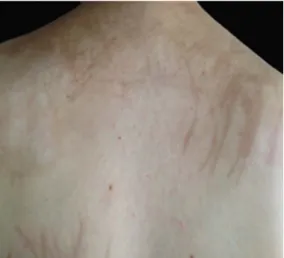CASE REPORT
Bleomycin-induced
fl
agellate hyperpigmentation
Cristina Resende, Catarina Araújo, Joana Gomes, Celeste Brito
Department of Dermatology and Venereology, Hospital de Braga, Braga, Portugal
Correspondence to Dr Cristina Resende, cristinapresende@gmail.com
To cite:Resende C, Araújo C, Gomes J,et al.
BMJ Case RepPublished online: [please includeDay Month Year] doi:10.1136/ bcr-2013-009745
SUMMARY
Bleomycin is a chemotherapeutic agent used in the treatment of different tumours. It has several side effects, includingflagellate hyperpigmentation, which is a unique and a well-documented side effect of bleomycin therapy. We report a case of a 23-year-old woman with a personal history of ovarian dysgerminoma, who developedflagellate hyperpigmentation on trunk after bleomycin therapy.
BACKGROUND
Bleomycin is a chemotherapeutic agent, which has been used in the treatment of lymphoproliferative syndromes, squamous cell carcinomas, ovarian germ cell tumours and testicular tumours.1 2Most organs contain a cysteine proteinase, capable of hydrolysing and inactivating bleomycin, except skin and lungs.2–4 The cutaneous-mucous side effects
of bleomycin are diverse, including alopecia, stomatitis, nail changes and hyperpigmentation.2 Hyperpigmentation associated with bleomycin may be diffuse, patchy or linear.3 5 Flagellate hyperpig-mentation is a linear or streaked pighyperpig-mentation, which is a well-documented side effect of bleo-mycin therapy with an incidence as high as 20%.1 4
CASE PRESENTATION
A 23-year-old woman presented with flagellate hyperpigmentation on her trunk. She had a history of ovarian dysgerminoma, treated with unilateral salpingo-oophorectomy and adjuvant chemother-apy. Chemotherapy included 20 mg/m2/day of
cis-platin and 100 mg/m2/day of etoposide intravenously, on days 1–5. She also received
bleo-mycin, 30 mg intravenously on days 1, 8 and 15. The cycle was repeated every 3 weeks until three complete cycles. Within 4 weeks after the treat-ment, painless, pruritic, flagellate hyperpigmenta-tion developed on her trunk. At presentahyperpigmenta-tion to our department, 5 months after the last cycle of chemotherapy, the skin examination revealed multiple curvilinear brownish hyperpigmented streaks, scattered profusely throughout her trunk (figures 1 and 2). There was no erythema, scaling or atrophy.
She had no alopecia and no changes in the appearance of nails or mucosa. She reported having no respiratory symptoms. On the basis of the history and examination, the diagnosis of bleomycin-induced flagellate hyperpigmentation was performed.
TREATMENT
Low-potency topical steroid was given to be applied to the pigmentation once a day, during 3 months. The patient was counselled that the
flagellate hyperpigmentation usually fades over a period of several months after the cessation of bleomycin.
OUTCOME AND FOLLOW-UP
During 8 months of the follow-up, the hyperpig-mentation in this patient persisted.
DISCUSSION
Bleomycin is a glycopeptide antibiotic commonly used for chemical pleurodesis, the treatment of cutaneous warts and the treatment of several human cancers, in particular lymphomas, ovarian and testicular germ cell tumours and squamous cell carcinomas.1 5
Flagellate hyperpigmentation can appear from 24 h to 9 weeks after the administration of bleo-mycin.1 6 It usually occurs after cumulative doses of 100–300 mg; however, it has been reported
after using lower doses, and there is a case described in the literature of flagellate hyperpig-mentation after intralesional injection of 14 units of bleomycin for plantar wart.2
Several hypotheses regarding the cause of hyper-pigmentation have been proposed, including induced lesions by scratching the skin and by irrita-tion from clothing, which permit the drug to leak out of blood vessels,6 increased levels of melanin because of various intercellular interactions and toxic effects of the drug itself.3 6
There is no specific treatment available forfl agel-late hyperpigmentation.3 5Pruritus may be treated with topical steroids and oral antihistamines.3 4
The course of bleomycin-induced flagellate hyperpigmentation is variable.1 The pigmentation
usually fades over 4 months, once the course of
Figure 1 Multiple curvilinear brownish hyperpigmented streaks, scattered throughout her upper trunk.
Resende C,et al.BMJ Case Rep2013. doi:10.1136/bcr-2013-009745 1
chemotherapy is complete and bleomycine is discontinued. Nevertheless, persistence of hyperpigmented streaks for up to 1 year after the treatment has been reported, like this case.3 4
Learning points
▸ Flagellate hyperpigmentation of the skin is a linear or streaked pigmentation, which is a well-documented side effect of bleomycin therapy with an incidence as high as 20%.
▸ There is no specific treatment available forflagellate hyperpigmentation, but pruritus may be treated with topical steroids and oral antihistamines.
▸ The pigmentation usually fades over 4 months, after bleomycine is discontinued. Nevertheless, persistence of hyperpigmented streaks for up to 1 year after treatment has been reported, like this case.
Contributors CR contributed with the bibliographic research, the diagnosis and treatment of the patient and the elaboration of the article. CA contributed with the bibliographic research. JG contributed in the diagnosis and the treatment of the patient. CB also contributed to the bibliographic research.
Competing interests None. Patient consent Obtained.
Provenance and peer reviewNot commissioned; externally peer reviewed.
REFERENCES
1 Al-Khenaizan S, Al-Berouti B. Flagellate pigmentation: a unique adverse effect of bleomycin therapy.Eur J Dermatol2011;21:146.
2 Abess A, Keel DM, Graham BS. Flagellate hyperpigmentation following intralesional bleomycin treatment of verruca plantaris.Arch Dermatol2003;139:337–9. 3 Silveira JC, Cunha BM, Estrella RR. Dermatiteflagelada induzida pela bleomicina.
Ann Bras Dermatol2006;81:83–5.
4 Nigro MG, Hsu S. Bleomycin-inducedflagellate pigmentation.Cutis2001;68:285–6. 5 Ibrahimi OA, Anderson RR. Images in clinical medicine. Bleomycin-inducedflagellate
hyperpigmentation.N Eng J Med2010;363:e36.
6 Gupta L, Tanwar RK, Khare A,et al. Bleomycin inducedflagellate pigmentation.
Indian J Dermatol Venereol Leprol2002;68:158–9.
Copyright 2013 BMJ Publishing Group. All rights reserved. For permission to reuse any of this content visit http://group.bmj.com/group/rights-licensing/permissions.
BMJ Case Report Fellows may re-use this article for personal use and teaching without any further permission.
Become a Fellow of BMJ Case Reports today and you can:
▸ Submit as many cases as you like
▸ Enjoy fast sympathetic peer review and rapid publication of accepted articles ▸ Access all the published articles
▸ Re-use any of the published material for personal use and teaching without further permission
For information on Institutional Fellowships contact consortiasales@bmjgroup.com
Visit casereports.bmj.com for more articles like this and to become a Fellow Figure 2 Multiple curvilinear brownish hyperpigmented streaks, scattered throughout her trunk.
2 Resende C,et al.BMJ Case Rep2013. doi:10.1136/bcr-2013-009745
